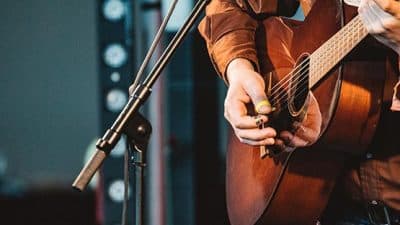Bishop’s Mantle column by Jim Bishop
“A dream is a wish your heart makes. . .” – Jiminy Cricket
Nearing the end of my illustrious high-school pilgrimage, my overriding dream – other than to graduate with some semblance of academic respectability – was to play music on the radio. I don’t mean sitting by my AM table model radio with my dial glued to 770, WABC, New York, or WIBG, 990, Philadelphia, although that’s how I spent many waking hours. I yearned to be a disc jockey, the guy with hits to my pits, who cranked out stacks of wax and pounds of sound to listeners who clung to my every word and phoned in requests and dedications.
In my wildest dreams, I envisioned myself becoming one of the “WIBBAGE” boss jocks – joining Joe Niagara, Big Tom Donahue, Jerry Stevens and Hi Lit in spinning the hits from the top 99 music survey, extending my telescope tongue to segues between Elvis, Dion and the Belmonts and Connie Francis, updating the weather for the Delaware Valley and promoting the next station-sponsored record hop in the Greater Philadelphia area.
That dream would slowly evaporate over the course of the summer of 1963 as I gathered, washed, graded and packed eggs on Abe Landis’ 12,000-layer poultry farm, with Joe “The Rockin’ Bird” Niagara’s voice emanating from my tinny Silvertone 6-transistor radio. I yearned to soar on wings of song, but I felt stuck in a chilly egg room.
Realizing late that summer that there might be more important things in life than having a car and some cash in my wallet, I applied at the 11th hour to then Eastern Mennonite College and set foot on campus for the first time as a freshman. It ranks today as one of the best decisions I ever made.
The school’s public-radio station, WEMC-FM, operated at the time from the balcony of the chapel (Lehman Auditorium). My sophomore year, 1964-1965, another student and I cohosted a weekly music program, “The Folks,” featuring traditional and contemporary folk-pop artists who were all the rage that year – Bob Dylan, Peter, Paul and Mary, Pete Seeger, The New Christy Minstrels, Chad Mitchell Trio, et. al.
A blurry dream began to refocus, but years would pass before it came to fruition. My first job after college graduation, a writing-editing position, took me to Elkhart, Ind., where Anna and I spent the next four years. Little did I dream then that I would one day return to work at my alma mater, but that’s what happened in 1971.
We’ve now lived in the ‘Burg nearly 36 years. I took some graduate classes at James Madison University during the 1981-1982 academic year. A broadcasting course required us to select a local radio station and write a major paper on its operations, program format and ethical issues. I selected WHBG, 1360 on the AM dial, with studios and transmitter on U.S. 11 south next to the Belle-Meade Restaurant.
Back then, this 5,000-watt independent station had real air personalities and an interesting music format of three oldies followed by a current Top 20 hit, providing much flexibility for the deejays to move in as well as take listener requests on a studio hotline. Interviewing the station manager and on-air staff led to my being invited to become a part-time weekend announcer, starting with a late Sunday afternoon air shift that expanded to a four-hour time slot and later working a Saturday shift as well. I developed the “Wax Museum,” featuring exclusively the artists and the music of the 1950s and early ’60s up to the start of the British Invasion.
Some evenings, I pretty much threw out my playlist as the phone rang off the hook with requests. What a learning experience. I worked weekends for nearly three years, 1982-1984, until the station was sold and moved to automated programming. I returned to WHBG briefly in 1993, reviving the “Wax Museum” show on Sunday evenings.
Near Christmas, 1999, Jim Britt, morning personality on Harrisonburg station WSVA, asked me to be a guest on his “Midday” program and bring an assortment of wacky yule tunes from my music library. The enthusiastic listener response surprised everyone, and Jim invited me to return in February to do two hours of “Warped Love Songs” for Valentine’s Day. The songs seemed to produce heartache and heartburn, and listeners called for more (not everyone learns from past mistakes).
The program soon became a monthly addition to the “Midday” lineup. I doubt if there’s another program like it anywhere in the country, at least on commercial radio.
The next show airs 10 a.m. to noon Thursday, April 19.
I’d been producing a weekly “EMU Activities Report” on university radio station WEMC for years, but in early 2000 the station manager invited me to put together a music program of my choice, and I readily agreed. Since the show would air one hour a week, I decided to play exclusively a cross-section of music of the 1950s. The “Friday Night Jukebox” debuted in February and has been going strong for seven years, currently airing in the 9-10 p.m. time slot.
And yes, I take listener requests.
The question haunting me now is, how long should I stay on the air, playing the music of yesteryear? Am I trying to convince myself that I’m still a kid, when really I’m a semi-fossilized throwback to the golden age of radio?
All I know is, I’m living a dream that took root more than 40 years ago. Turntables and vinyl records have been replaced by computer hard drives and digital consoles, but the old gold still sounds like only yesterday, and these memory-making melodies can’t be heard elsewhere – other than on Internet or satellite radio stations.
So for now, like the late Joe Niagara used to say, “Let’s head back to Revivalville,” and keep on making my rock-and-roll radio dreams come true.
Jim Bishop is the public-information officer at Eastern Mennonite University.










